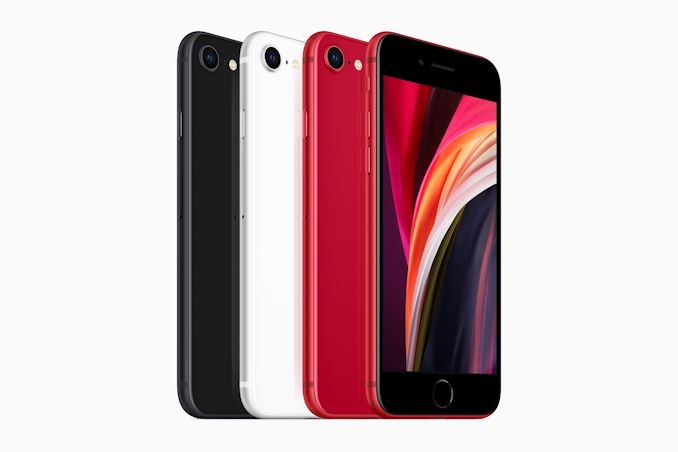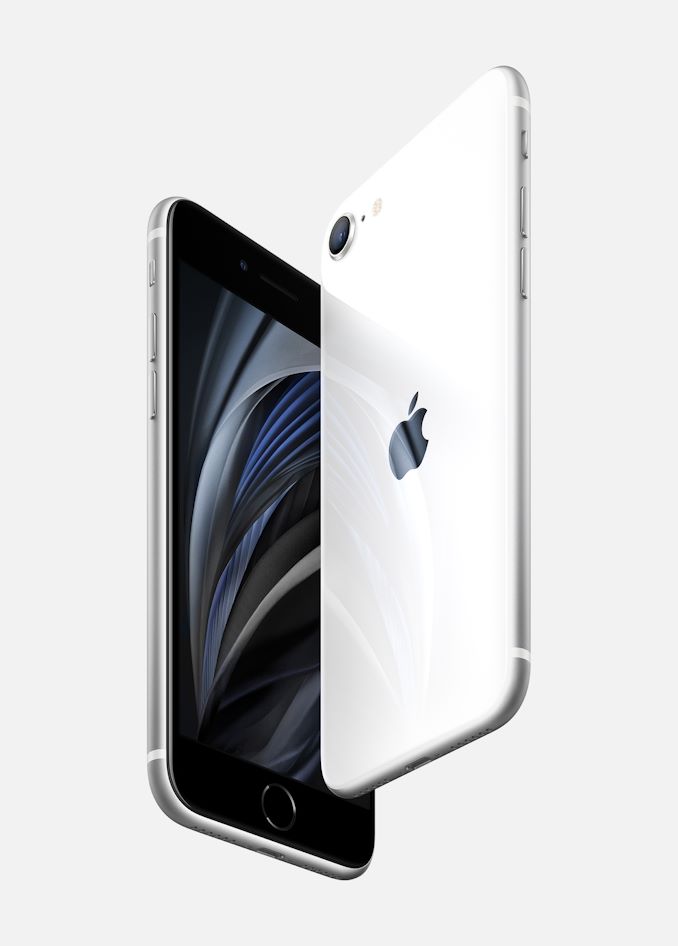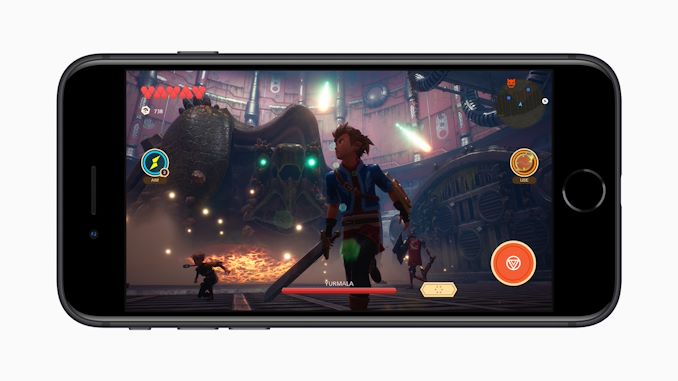Apple Announces New Updated iPhone SE: A13 & New Features for $399
by Andrei Frumusanu on April 15, 2020 1:00 PM EST- Posted in
- Mobile
- Apple
- Smartphones
- iPhone SE 2020

Apple’s last “classic” iPhone release was the iPhone 8 back in 2017, with the 2016 iPhone SE (Special Edition) being the last iteration donning the iPhone 4 design language. It’s safe to say both these devices had been getting a bit long in the tooth, and there’s still plenty of people out there which loved the 4.7” form-factor – and possibly unwilling to update to the newer bigger models.
Luckily, Apple seemingly agrees that this market is worth covering, and today announced a refresh of the 2016 iPhone SE. The new 2020 special edition model takes its design cues from the iPhone 8, essentially taking it as a blueprint for the shell of the phone, and crams in the latest hardware technology that were premiered with the iPhone 11 series.
Most importantly, Apple is offering this new small fierce package at an incredible price point starting at $399, significantly cheaper than even the “lower-end” iPhone 11. The combination seems an outright winner, let’s go over the specifications:
| Apple 2019-2020 iPhone Specifications | |||||
| iPhone 11 Pro | iPhone 11 Pro Max | iPhone 11 |
iPhone SE
|
||
| SoC | Apple A13 Bionic 2 × Lightning Performance @ 2.66GHz 8MB L2 4 × Thunder Efficiency @ 1.73GHz 4MB L2 |
||||
| GPU | Apple, 4 Cores | ||||
| DRAM | 4GB LPDDR4X | ?? | |||
| Display | 5.8-inch OLED 2436×1125 DCI-P3/True Tone 800 cd/m² brightness 2M:1 contrast ratio |
6.5-inch OLED 2688×1242 DCI-P3/True Tone 800 cd/m² brightness 2M:1 contrast ratio |
6.1-inch LCD 1792×828 DCI-P3/True Tone 625 cd/m² brightness 1400:1 contrast ratio - |
4.7-inch LCD 1334×750 DCI-P3/True Tone 625 cd/m² brightness 1400:1 contrast ratio - |
|
| Size | Height | 144.0 mm | 158.0 mm | 150.9 mm | 138.4 mm |
| Width | 71.4 m | 77.8 mm | 75.7 mm | 67.3 mm | |
| Depth | 8.1 mm | 8.1 mm | 8.3 mm | 7.3 mm | |
| Weight | 188 grams | 226 grams | 194 grams | 148 grams | |
| Battery Life | 3046mAh +14.5% capacity "+4H vs XS" |
3969mAh +25% capacity "+5H vs XS Max" |
3110mAh +5.7% capacity "+1H vs XR" |
?? | |
| Wireless Charging | Qi | ||||
| Rear Cameras | Main | 12 MP 1.4µm Dual Pixel PD f/1.8, OIS Wide Color Gamut Quad LED True Tone Flash |
12 MP 1.4µm f/1.8, OIS Wide Color Gamut Quad LED True Tone Flash |
||
| Tele- Photo |
12 MP f/2.0 Telephoto, OIS 2x Optical Zoom |
- | - | ||
| Wide | 12MP f/2.4 120° Ultra-wide Angle |
- | |||
| Front Camera | 12MP f/2.2 Wide Angle | 7MP f/2.2 | |||
| Storage | 64 GB 256 GB 512 GB |
64 GB 256 GB 512 GB |
64 GB 128 GB 256 GB |
64 GB 128 GB 256 GB |
|
| I/O | Apple Lightning | ||||
| Wireless (local) | 802.11ax Wi-Fi with MIMO + Bluetooth 5.0 + NFC | ||||
| Cellular | Gigabit-class LTE-A 4x4 MIMO and LAA |
Gigabit-class LTE-A 2x2 MIMO and LAA |
Gigabit-class LTE-A |
||
| Splash, Water, Dust Resistance | IP68 up to 2 meters (Pro models = 4 meters), up to 30 minutes |
IP67 up to 1 meters, up to 30 minutes |
|||
| Dual-SIM | nano-SIM + eSIM | ||||
| Launch Price | 64 GB: $999 / £1049 / 1149€ 256 GB: $1149 / £1199 / 1319€ 512 GB: $1349 / £1399 / 1549€ |
64 GB: $1099 / £1149 / 1249€ 256 GB: $1249 / £1299 / 1419€ 512 GB: $1449 / £1499 / 1649€ |
64 GB: $699 / £729 / 799€ 128 GB: $749 / £779 / 849€ 256 GB: $849 / £879 / 969€ |
64 GB: $399 / £419 / €479 128 GB: $449 / £469 / €529 256 GB: $549 / £569 / €649 |
|
In terms of hardware, the new 2020 iPhone SE is powered by Apple’s latest A13 chip. Currently this is the most powerful and power efficient mobile chip on the market, and Apple integrating this into the new generation SE probably results in the phone packing quite a punch for its size.
Connectivity wise, it’s also on par with the iPhone 11, featuring “gigabit-class” LTE-A cellular as well as the newest WiFi 6 chipsets for better reception on crowded compatible networks.
We currently don’t have information on the DRAM configuration of the phone, but hopefully Apple doesn’t differ it too wildly from the 4GB standard setup on the iPhone 11 models.
Design-wise, the new iPhone SE should be a very familiar sight to users as it adopts the iPhone 8 design language and frame. This includes a 4.7” 1334 x 750 resolution LCD panel – which in likelihood will be the same as that found on the iPhone 8.
The form-factor nowadays would seem outright diminutive as the phone is smaller in every dimension, coming in at only 138.4 x 67.3 x 7.3mm and weighing in only 148g. If you’ve been looking to get a smaller phone and are in the iPhone ecosystem, the new iPhone SE is the device to get.
On the camera side, the SE only has a single camera – a 12MP sensor with f/1.8 optics and OIS. This isn’t the newer generation sensor found on the iPhone 11 series as it lacks the full-sensor dual-pixel phase detection capability, so it’s likely the unit from the previous XS or iPhone 8 generation. However this doesn’t mean that picture quality will be any less, as Apple promises the phone to perform as the “best single-camera system ever in an iPhone”, and the A13’s new ISP and image processing algorithms will certainly augment the camera to be extremely competitive with what we’ve seen in the iPhone 11 series.
As the phone still features a physical home button, the preferred method of unlocking is Touch ID as the phone lacks the relevant Face ID sensor hardware. Again, iPhone users will be extremely familiar with the setup here as it’ll be essentially the same as what’s found on an iPhone 8.
A Product That Speaks For Itself - Starting At $399
All in all, the iPhone SE is a product that essentially speaks for itself. It’ll be fulfilling the nostalgia needs of users who had been apprehensive to move onto Apple’s newer “iPhone X” design iteration of phones, all whilst updating the internal hardware of the phone in order to not be left out of the generational technology improvements seen by the newest silicon.
It also represents amongst the smallest phones on the market right now – you’d have a very hard time finding similar form-factor smartphones, let alone iPhones.
Apple’s aggressive pricing of starting at $399 for the 64GB base model is going to make this phone a runaway success, even undercutting the iPhone 8 that had been selling for $449 until now (and has now been discontinued). Even the higher storage variants at 128 and 256GB seem outright reasonable at $449 and $549, undercutting the iPhone 11 by $300. European prices start at £419 in the UK and 479€ in continental Europe – a 10% premium on top of the usual VAT margin, so not quite as an aggressive pricing scheme as in the US.
Pre-orders start this Friday, April 17th, with in-store availability next Friday, April 24th.













109 Comments
View All Comments
nathanddrews - Thursday, April 16, 2020 - link
That "few" mm is not what my mom wants though. I can't blame her. The X is ultimately 5-10% larger and 25% heavier than the new SE. Dimensions aside the X is significantly slower, less efficient, and less capable.Midwayman - Monday, April 20, 2020 - link
It has a better higher resolution screen and a better camera system. Depends what you value I suppose. Going back to a single camera system would be painful for me.s.yu - Monday, April 20, 2020 - link
Arguably, this single camera is better than that dual camera. The CMOS is slightly updated with support for a night mode which isn't available on the X, and it literally makes a day and night difference in low light, OTOH the smaller 2x module with a slower lens is usable in even fewer circumstances than the wide without night mode.5080 - Wednesday, April 15, 2020 - link
Great price for an iPhone, but look at that tired design.SolarBear28 - Wednesday, April 15, 2020 - link
Yes, but I would think part of the reason its so cheap is because they didn't redesign it and also reused some manufacturing equipment. Personally I might consider this as my next phone because everything in the Android world is 6"+ with super tall aspect ratios (although I love my current phone with Samsung's One Hand Operation Plus gestures). I don't really care if my phone has a new or original external design.mantikos - Wednesday, April 15, 2020 - link
I assure you the cheaper price has nothing to do with using old tooling. What do you think the BOM is on a new flagship device?iphonebestgamephone - Thursday, April 16, 2020 - link
So operating the tools for making an iphone x costs the same as an 8?close - Thursday, April 16, 2020 - link
The cheaper price has *a lo* to do with the old tooling but it's not the operation itself (which is pretty much identical) that makes the difference. Almost anything gets cheaper in time as the tooling is amortized and taken out of the cost. This way Apple still gets to extract value out of the old tooling that would otherwise have to be retired. And manufacturing a low cost phone on the new tooling would just take away capacity from the new high-end models. Chip manufacturers also repurpose old fabs, tooling, fabrication processes towards making chipsets, network chips, and all kinds of controllers that shouldn't take way capacity from their modern CPUs.The other reason it's cheap is that except for the SoC they use previous generation parts and design in other places. The BOM is certainly lower given the use of cheaper single camera setup, no FaceID, smaller battery, etc. Which again means they don't have to take away any capacity from the new models.
zeeBomb - Wednesday, April 15, 2020 - link
The design aged like fine wine if you ask me. And it being 4.7inches..i may sound like a fanboy, but it's perfect!heffeque - Wednesday, April 15, 2020 - link
For a 4.7 inch phone, the size of the phone is HUGE in today's standards.Maintaining the phone size, an "all screen phone" could have had a 5.8 inch screen.
Maintaining the screen size, an "all screen phone" could have been MUCH smaller than that thing.